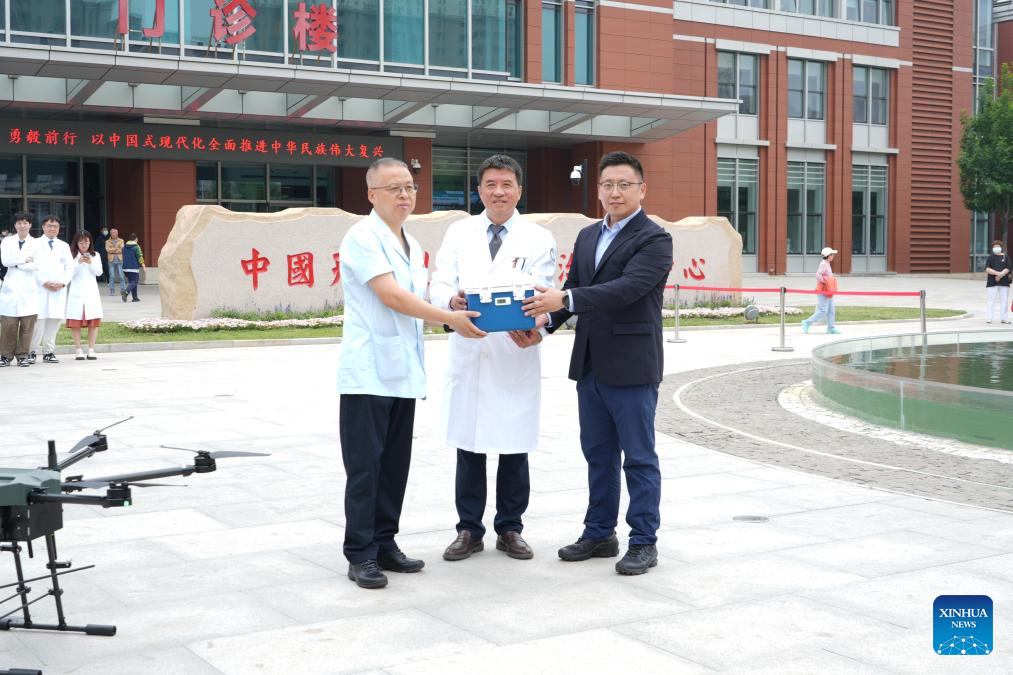Drones empower China's medical emergency systems


BEIJING -- China is rapidly integrating drone technology into its medical emergency systems, with breakthroughs in multiple cities demonstrating enhanced efficiency in critical care logistics.
North China's Tianjin municipality launched its first medical drone route in late May, marked by a successful simulated emergency blood supply test flight. The flight connected a blood station at the Binhai New Area and the Tianjin Medical University Cancer Hospital's Binhai branch.
"The drone route creates an emergency blood lifeline for patients in critical conditions," said Shen Jun, vice-president of the hospital.
Carrying a 5-kg payload, the drone is equipped with a temperature-controlled medical box that allows for temperature, location and flight status monitoring in real-time. Its efficient point-to-point delivery avoids delays caused by road traffic, saving precious time for emergency treatment.
Amid the rapid growth of China's low-altitude economy, low-altitude medical services, as a niche sector, are expanding their applications, driving an unprecedented transformation in healthcare.
In November 2024, the National Healthcare Security Administration added "air medical transport" to the national medical service price catalog, mandating standardized pricing in the country's provincial areas by the end of May this year. Commercial health insurance providers are also encouraged to explore coverage for these services. The guideline has accelerated the adoption of low-altitude aircraft in medical applications.
Bolstered by technology and policy support, Chinese provinces like Zhejiang, Guangdong and Fujian are actively exploring the application of drones in their medical systems, transporting test samples, blood, emergency supplies and medicine, which are crucial for saving critical treatment times.
In the city of Zigong, Southwest China's Sichuan province, drones have become a routine part of medical services.
According to the municipal health commission, the city has opened 25 low-altitude routes linking 28 sites for medical transport. As of May 27, drones had completed 5,270 flights for medical use.
The drones are automated, cloud-controlled models built for urban operations. Cruising at 72 km per hour with an 18-km range, they operate 70 percent to 80 percent faster than ground transport.
"Usually, it takes at least 30 to 40 minutes from the hospital branch of Bancang to the headquarters by ground transportation. Drones cut this to 11 minutes," said Huang Yuting, transport manager at Zigong First People's Hospital, referring to a case in which a drone delivered a drug for emergency use last August.
Hao Jihui, president of Tianjin Medical University Cancer Hospital, said the low-altitude transport system breaks geographical barriers, enhances emergency response, and significantly improves medical resource efficiency by cutting costs and transportation times.
"We'll expand drone applications to enhance cross-regional medical resource allocation and meet multi-level health service demands," Hao added.
- Drones empower China's medical emergency systems
- Chinese team achieves 300-km quantum direct communication milestone
- Beijing upgrades inbound travel services as visitors surge in January-April
- Chinese scientists develop degradable coating to tackle marine biofouling challenges
- Man detained over death of 2 Japanese
- Chinese, German scientists discover super-Earth planet in Sun-like star's habitable zone





































